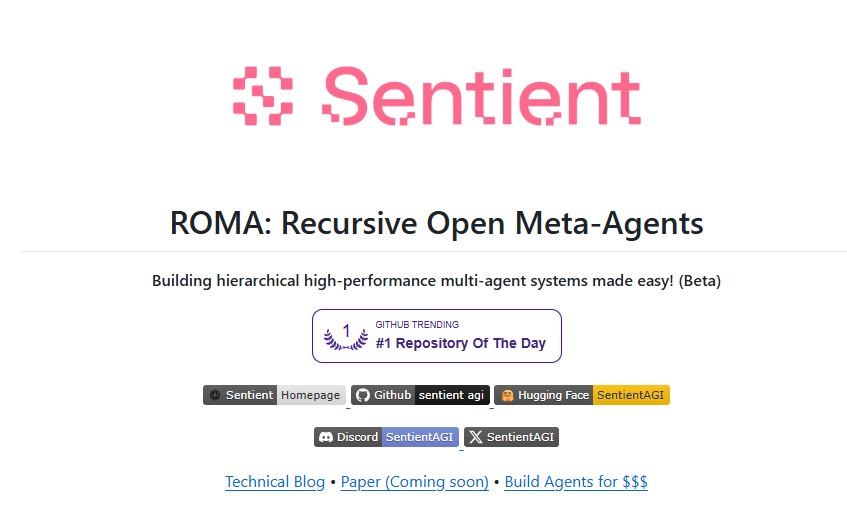Artificial Intelligence continues to evolve at an unprecedented pace, with agent-based frameworks becoming increasingly important for tackling complex problems. ROMA (Recursive Open Meta-Agents) represents a significant leap forward in this space, providing developers and researchers with a hierarchical, flexible, and high-performance framework for building multi-agent AI systems.

This article explores ROMA’s architecture, technical capabilities, practical use cases, and installation guide, offering insights for AI enthusiasts, developers, and organizations looking to leverage the next generation of agent frameworks.
Understanding ROMA: The Core Concept
It is a meta-agent framework designed to decompose complex tasks into manageable subtasks using a recursive hierarchical structure. By breaking tasks into atomic units that can be executed in parallel, it enables efficient problem-solving while maintaining full transparency. This transparency allows developers to trace each step, debug effectively, and iterate quickly on agent behavior.
Unlike traditional agent systems, which may handle tasks linearly, ROMA’s recursive architecture ensures that tasks are planned, executed, and aggregated in a loop, making it ideal for applications requiring sophisticated reasoning and multi-step solutions.
Key Components
It operates through a structured plan–execute–aggregate loop, which ensures that complex tasks are handled efficiently:
- Atomizer – The Atomizer determines whether a task is atomic (directly executable) or requires further planning. Atomic tasks are immediately handed to the executor.
- Planner – If a task is complex, it is broken down into smaller subtasks. Each subtask is recursively passed back to the Atomizer for further evaluation.
- Executor – Executors perform atomic tasks. These can include LLMs, APIs, or other agents, as long as they implement a standardized
agent.execute()interface. - Aggregator – Once all subtasks are executed, the Aggregator combines the results into a coherent solution for the parent task.
This recursive structure ensures top-down task decomposition, bottom-up aggregation, and left-to-right dependency handling, enabling sophisticated multi-agent workflows to function smoothly and reliably.
Technical Stack and Installation
ROMA is built with a modern, scalable stack to support diverse agent operations:
- Framework: AgnoAgents for hierarchical agent orchestration.
- Backend: Python 3.12+ with FastAPI or Flask.
- Frontend: React + TypeScript, supporting real-time WebSocket communications.
- LLM Support: Flexible integration with any provider via LiteLLM.
- Data Persistence: Enterprise-grade S3 integration with goofys FUSE mounting.
- Security: Production-grade validation, path injection protection, and AWS credential verification.
- Code Execution: E2B sandboxes for safe, isolated execution of untrusted code.
Explore here : ROMA GitHub Repository
Quick Setup
For developers who want to get started immediately, ROMA provides a one-command setup:
git clone https://github.com/sentient-agi/ROMA.git cd ROMA ./setup.sh
You can choose between Docker setup (recommended for isolation) or native installation for development purposes. ROMA also supports optional E2B sandbox integration, enabling secure code execution with full S3 data persistence.
Pre-Built Agents and Use Cases
ROMA includes several pre-built agents to demonstrate its capabilities:
- General Task Solver – Handles diverse queries with adaptive planning and multi-domain knowledge. Ideal for research, fact-checking, and exploratory analysis.
- Deep Research Agent – Breaks down research questions into search, analysis, and synthesis subtasks. Perfect for academic research, market analysis, and technical documentation.
- Crypto Analytics Agent – Provides deep financial and blockchain analysis using real-time market data, on-chain analytics, and DeFi metrics. Secure execution occurs in E2B sandboxes.
These agents highlight ROMA’s flexibility and performance, showing how complex queries can be handled recursively, with independent subtasks running in parallel.
Advantages of ROMA
- Recursive Task Decomposition – Handles multi-step problems efficiently, with intelligent dependency management.
- Parallel Execution – Tasks are executed simultaneously where possible, reducing processing time.
- Agent Agnostic – Works with any provider or LLM as long as it supports
agent.run(). - Transparency – Stage tracing ensures each step of execution is visible for debugging and optimization.
- Integration-Friendly – External tools, APIs, and protocols can be seamlessly connected, enabling diverse applications.
Benchmarks and Performance
ROMA has been tested across multiple benchmarks, demonstrating its high-performance capabilities:
- SEAL-0 – Evaluates search-augmented LLMs on fact-seeking tasks with noisy or conflicting data.
- FRAMES – Assesses reasoning and multi-step task execution.
- SimpleQA – Measures agent performance on straightforward question-answering tasks.
Results indicate that ROMA’s recursive, hierarchical approach provides better accuracy, faster execution, and improved task management compared to single-pass systems.
Getting Started with Your First Agent
Creating an agent in ROMA is simple:
from sentientresearchagent import SentientAgent
agent = SentientAgent.create()
result = await agent.run("Create a podcast about AI safety")
Within minutes, developers can have fully functioning agents performing tasks with minimal setup.
Conclusion
ROMA offers a powerful, flexible, and transparent framework for building hierarchical multi-agent systems. Its recursive architecture, parallel execution, and agnostic design make it suitable for research, enterprise applications, and AI experimentation. Whether you are building a general-purpose research assistant, a crypto analytics agent, or experimenting with new AI workflows, ROMA provides the tools and structure needed to implement high-performance multi-agent solutions efficiently.
With its open-source approach, community-driven development, and pre-built templates, ROMA is poised to become a go-to framework for recursive AI agents, enabling developers and researchers to push the boundaries of multi-agent AI.
Follow us for cutting-edge updates in AI & explore the world of LLMs, deep learning, NLP and AI agents with us.
Related Reads
- How oLLM Makes Large-Context AI Models Run Smoothly on 8GB GPUs
- Gamma PPT AI : Unlock Presentations in Minutes
- PyMuPDF: The Ultimate Python Library for High-Performance PDF Processing
- Ling-1T by inclusionAI: The Future of Smarter, Faster and More Efficient AI Models
- OpenAI’s AgentKit: Transforming How Developers Build and Deploy AI Agents
References
The Open-Source Meta-Agent That Outperforms Deep Research (YouTube)

1 thought on “ROMA: The Ultimate AI Framework That Lets You Build High-Performance Agents in Minutes”